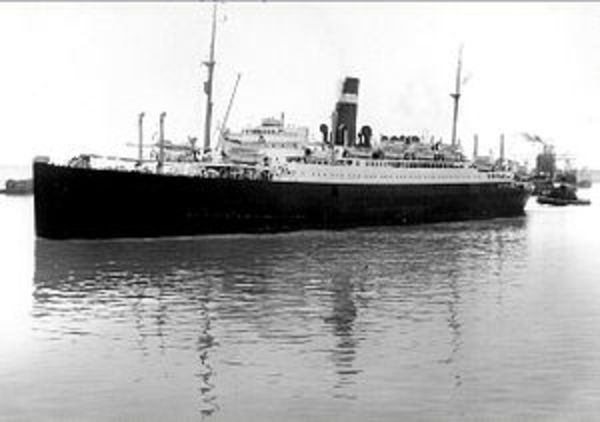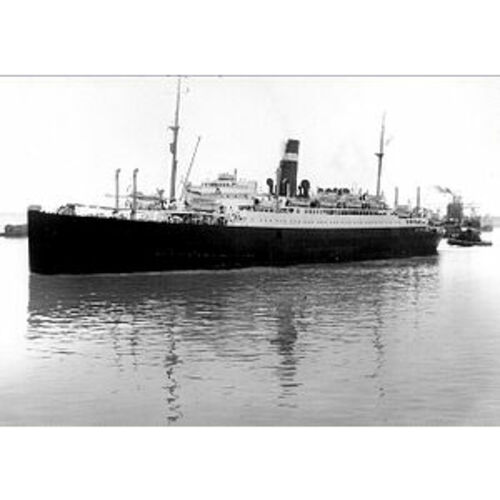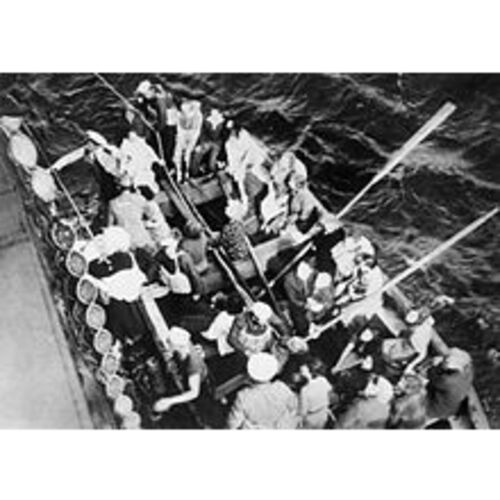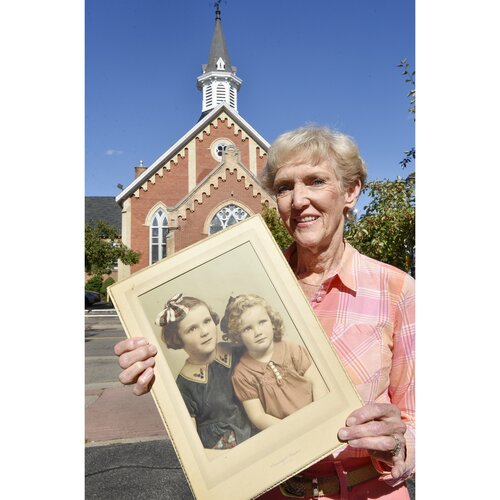
Source: Courtesy of Wikimedia Commons
HAYWORTH, MARGARET JANET, schoolgirl; b. 21 Aug. 1929 in Hamilton, Ont., the elder daughter of John Smith Ward Hayworth and Georgina Wright; d. at sea 9 Sept. 1939 aboard the freighter City of Flint.
Margaret Janet Hayworth was born in Mount Hamilton Hospital to Scottish immigrants who lived in Burlington, Ont., where she attended Lakeshore Public School and Knox Presbyterian Church Sunday school. In 1939 the family was preparing for a move. They had decided to sell their house, spend the summer with relatives in Scotland, and relocate to Hamilton Beach (Hamilton), on the eastern side of Hamilton Harbour, after their trip. Both Margaret and her five-year-old sister, Jacqueline Anne, would then go to A. M. Cunningham School.
On 23 June, once Margaret had finished Grade 5, the family sailed from Montreal for Glasgow aboard the Donaldson Atlantic Line passenger ship Athenia. After visiting his and his wife’s parents in Falkirk and Aberdeen, John returned home to work at the Firestone Tire and Rubber Company. Georgina and the girls stayed on, intending to travel back to Canada in mid September on the Athenia’s sister ship, Letitia. (The Hayworths knew both ships, for John had immigrated to Canada in 1925 on the Athenia and Georgina in 1927 on the Letitia.) As the threat of war intensified in the weeks following, John wired Georgina, urging her to depart immediately. She replied that she had booked an earlier passage.
The Hayworths left Glasgow aboard the Athenia midday on 1 September. The ship stopped to pick up more passengers, first in Belfast that evening and in Liverpool the next day, then set out across the north Atlantic with over 1,400 aboard; most were Canadians and Americans escaping the mounting turmoil in Europe. Two days after the Athenia’s departure, Great Britain and France declared war on Germany. That evening, 3 September, as the vessel was cruising 200 miles west of the Hebrides, the Hayworths were enjoying the air on deck. Georgina was thinking of taking the girls to the cabin but decided that it was too beautiful an evening to go inside early. Suddenly there was a massive explosion. The ship had been torpedoed by a German submarine, which some of the passengers had spotted just moments before. (It was later identified as U-30 under the command of Fritz-Julius Lemp. He would deny that he had known the vessel was a passenger ship.) Flying debris struck Margaret on the head, knocking her unconscious. Georgina, with Jacqueline holding onto her skirt, carried her bleeding daughter to the nearest lifeboat station. Georgina managed to get Margaret into a boat and climb in, too. She turned back towards the deck and shouted to a man to hand her Jacqueline, but in the confusion he picked up the wrong child. She called to another man, but he too handed over someone else’s child. The crew started to lower the lifeboat, and the family was separated.
Having received the ship’s SOS, rescuers started arriving within a few hours. Georgina and Margaret were among the more than 200 who were taken aboard the Southern Cross, a private yacht owned by a Swedish millionaire. All of them were later transferred to the small American freighter City of Flint. (Jacqueline, the Hayworths would eventually find out, was helped by another Canadian woman with a young daughter, and they were among those saved by a vessel that returned to Scotland. She was reunited with her grandparents, and a family friend brought her back to Canada in October.)
The City of Flint was ill equipped to handle passengers, but the deck was cleared so that makeshift shelters could be erected. Margaret and the other injured were put in the care of Richard L. Jenkins, a physician who had come aboard from an American liner that donated supplies. Initially, Margaret’s health seemed to improve, but on the fifth day she developed a fever and began drifting into unconsciousness, occasionally waking up crying or singing bits of hymns. On 8 September she asked for Jacqueline, then slipped into unconsciousness for the last time and died in the early hours of the 9th.
John Hayworth was first informed that his wife and both daughters had survived, but en route to Halifax to meet the City of Flint he learned of Margaret’s death. While many on the dock celebrated joyful reunions, John greeted his distraught wife. They purchased a small coffin in Halifax, and began preparations for the journey home and a quiet burial. A family friend selected a plot in Hamilton’s Woodland Cemetery. Meanwhile, arrangements were being taken out of their hands. Ontario premier Mitchell Frederick Hepburn*, eagerly grasping any opportunity to bolster support for the war, decided that the girl should have a public funeral. The Hayworths were simple, private people who disliked ostentation. Friends were diplomatic, telling the press that the couple had never wanted a public funeral but “will understand what has prompted it.”
A flock of dignitaries, including Hepburn and provincial Conservative leader George Alexander Drew*, attended a special session of Hamilton City Council, where they used the occasion to transform the young victim into a martyr for the Allied cause. By the time the body arrived in Hamilton at 6:40 p.m. on the 15th, five days after Canada had entered the war, Margaret Hayworth was an international celebrity, eulogized in the Times of London and the New York Times (after the funeral a commemorative poem by Dr Jenkins would be published in Time magazine). Crowds lined the streets to the funeral home, where the plain pine coffin was replaced with a silk-lined one for the open-casket visitation organized by the politicians (the press referred to it as a lying-in-state). A small posy from one of Margaret’s schoolmates and two rosebuds were placed in her hands.
Hundreds processed through the funeral home on the evening of the 15th and again the next morning. There was then a service at the home of close friends, one of the few times the Hayworths could grieve privately, before the public funeral that afternoon at St Andrew’s Presbyterian Church, which was filled to capacity; thousands more gathered outside to listen via loudspeakers. Margaret’s parents, schoolmates, and family friends sat in the front, followed by rows of politicians and other dignitaries, including Lieutenant Governor Albert Edward Matthews*, the premier, and most members of city council. Georgina chose hymns that Margaret had sung before losing consciousness for the last time, and the pall-bearers were friends, but almost every other aspect of the funeral – from the military honour guard to the Ontario Provincial Police motorcycle escort to the government cameraman who filmed the event – was someone else’s doing, with Hepburn being the chief orchestrator. He had even contacted all the other provincial governments to suggest they follow Ontario’s lead and fly flags on public buildings at half mast on the day of the funeral. Prime Minister William Lyon Mackenzie King*, who learned of Hepburn’s actions from a newspaper report, grumbled in his diary on 15 September that the premier “has tried to put me in the position of either following him as a jingo or refusing to follow, and being unpatriotic. I do not intend to have this war run on the basis of stunts and on the basis of hatred and the like.” King decided that the federal government’s participation would be more modest: an official representative and a tasteful wreath, sent on behalf of the people of Canada.
King’s hopes that the death of Margaret Hayworth would remain above wartime rhetoric were dashed: because the funeral was a public event, it was also a propaganda gold mine. Journalists likened the sinking of the Athenia to that of the Lusitania in 1915 and compared Margaret to Edith Louisa Cavell, the British nurse executed during World War I. The child’s death was incontrovertible proof of the evil of Nazism, observed the Reverend Charles Lynch Cowan, one of the clergymen presiding at the service; the torpedo that sank the Athenia, he stated, “smashed our placid, self-confident pacifism and leeringly reminded us that heartless force is still to be reckoned with.” That her loss proved the absolute necessity of prosecuting the war must be clear everywhere, he continued, not just in Canada and the British empire. For Conservative leader George Drew, the casualty was an argument against American isolationism: “The symbol of this child’s death will go from the bounds of this Dominion as a challenge to all democratic nations.… The people of the United States have as direct a concern as we have as to the course of the conflict.”
Margaret Hayworth was not the first Canadian to die in the war – that sad honour belongs to more than 50 others who perished when the Athenia was hit or in the chaotic hours that followed – but she was the first whose body was brought home for burial. Before the hasty departure from Scotland, Georgina Hayworth had decided not to tell her daughters about the impending war, believing that they were too young to understand. It is ironic that Margaret became one of the initial victims in a battle she could scarcely have comprehended.
The author wishes to thank Jacqueline Hayworth Bullock of Burlington, Ont., for sharing the few family records in her possession and her memories of her sister.
City of Toronto Arch., Fonds 1266, images 60728; 60735; 60737. Hamilton Public Library, Special Coll. Dept. (Ont.), Clipping files, Hamilton biog. LAC, “Diaries of William Lyon Mackenzie King,” 15 Sept. 1939: www.bac-lac.gc.ca/eng/discover/politics-government/prime-ministers/william-lyon-mackenzie-king/Pages/diaries-william-lyon-mackenzie-king.aspx (consulted 9 April 2014); “Passenger lists and border entries, 1925–1935 – Nominal indexes”: www.bac-lac.gc.ca/eng/discover/immigration/immigration-records/passenger-lists-border-entry-1925-1935/Pages/introduction.aspx (consulted 9 April 2014). Evening Telegram (Toronto), 16 Sept. 1939. Globe and Mail, 14, 16, 18 Sept. 1939. Hamilton Spectator, 4, 8, 11, 14, 15, 16, 18 Sept. 1939. New York Times, 10, 14, 17 Sept. 1939. Times (London), 11 Sept. 1939. Toronto Daily Star, 13, 16 Sept., 23 Oct. 1939. “Canada: peace,” Time (New York), 25 Sept. 1939. F. M. Carroll, “The first shot was the last straw: the sinking of the T.S.S. Athenia in September 1939 and British naval policy in the Second World War,” Diplomacy & Statecraft (London), 20 (2009): 403–13. Max Caulfield, A night of terror: the story of the “Athenia” affair (London, 1958); repr. as Tomorrow never came: the story of the S.S. “Athenia” (New York, 1959). Twilight of an era (1934–1939), produced, directed, and written by William Weintraub (short film, [Ottawa], 1960; available online at www.nfb.ca/film/twilight_of_an_era).
Cite This Article
Jonathan F. Vance, “HAYWORTH, MARGARET JANET,” in Dictionary of Canadian Biography, vol. 16, University of Toronto/Université Laval, 2003–, accessed December 31, 2025, https://www.biographi.ca/en/bio/hayworth_margaret_janet_16E.html.
The citation above shows the format for footnotes and endnotes according to the Chicago manual of style (16th edition). Information to be used in other citation formats:
| Permalink: | https://www.biographi.ca/en/bio/hayworth_margaret_janet_16E.html |
| Author of Article: | Jonathan F. Vance |
| Title of Article: | HAYWORTH, MARGARET JANET |
| Publication Name: | Dictionary of Canadian Biography, vol. 16 |
| Publisher: | University of Toronto/Université Laval |
| Year of publication: | 2016 |
| Year of revision: | 2016 |
| Access Date: | December 31, 2025 |






